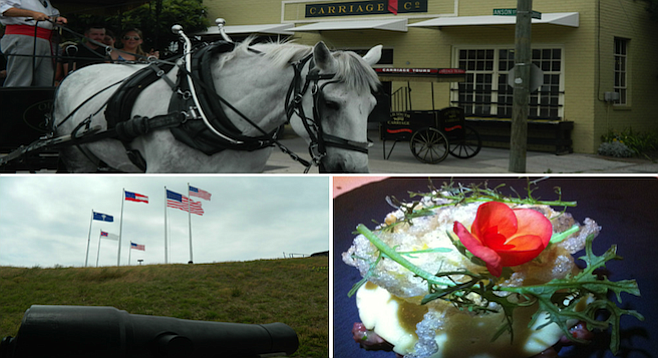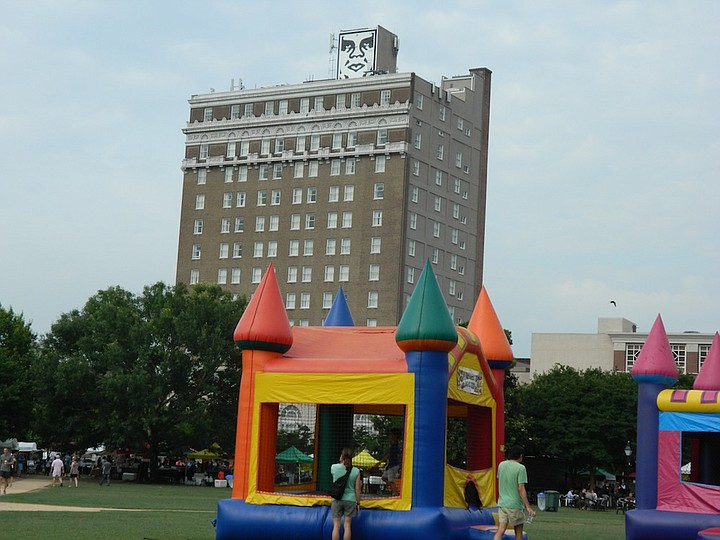 Facebook
Facebook
 X
X
 Instagram
Instagram
 TikTok
TikTok
 Youtube
Youtube

What comes around, goes around. Charleston was one of the most renowned, prosperous cities in colonial and antebellum America. Gone with the Wind’s character Rhett Butler was ostensibly from Charleston, to demonstrate how sophisticated, well-born and used to the finest things in life he was. But the city’s participation in the opening shots of the Civil War destroyed Charleston’s fortune for decades.

Today, Charleston has several colleges, an important port and tourism that have brought a return of good living with a bang. Its long history of an admixture of various cultures – English, French Huguenot, Sephardic Jewish, African-American, Scottish, Irish, German – along with prized seafood and unique produce – have contributed to a mouth-watering restaurant scene.
There are some times of the year (graduation week, summer wedding season, etc.) when if you want to stay in the historic parts of Charleston, you’d better make your reservations far, far in advance. Fulton Lane Inn offers a boutique hotel ambiance. Its entrance is tucked away on one of the city’s historic alley/lanes, so it feels extra private/rockstar, yet it’s steps away from a world of luxury boutiques and eateries. Their décor has a light, summery Colonial feel.
The opening shots of the Civil War were fired here. Fort Sumter – on an island – has National Park Service experts, a museum and a bookstore. These are all accessible only by stair climbing. There are two options to get to Fort Sumter: by private boat or by the NPS’ authorized concession boat. The concession boat charges a fee, though the park itself is free. They “highly” suggest buying your tickets before the date of travel, but I got mine the same day and it worked out fine. Make your history learnin’ a party: in warm weather, there’s a Friday sunset boat with beer, wine, cocktails and free hors d’oeuvres.

Charleston Farmers Market is open Saturdays April–November, with a special holiday market in December. It’s really more like a festival than your typical farmers market: live music, lots of locally prepared foods, artisans and even pony rides turn it into a popular event. Of course, they also boast super-colorful produce soaking up all that Southern sun.
After diving into such “sometimes foods” as Yardbirds Fried Chicken with “waffled” French toast, does it seem painfully unfair that the nearby dress shops on King Street only carry trophy wife sizes? Yes, yes it does!
Think of Butcher & Bee, on the edges of town in a yet-to-be gentrified neighborhood, as a casual almost-gastropub. It’s BYOB! Long, family-style tables make it easy to meet locals as you indulge in chef favorites as chilled butter bean salad with soft boiled egg, fresh dill and parsley, or pork belly with green onions, creamer potatoes, collards, soft boiled eggs and white corn.
I read about Charleston's Leon's Fine Poultry & Oysters in the very chi-chi Southern mag Garden & Gun. Still, not even all the locals have been there...yet. It's in a neighborhood that's on the verge of gentrifying and you'll totally be able to remember where they're located: the corner of King and I!
Char-grilled oysters are a Charleston thing; I had never had them before. They became an instant new favorite. Char-grilling brings out their meatiness and the lemon, parsley, butter and Parmesan that flavors them is a great match. Fried Oysters Rockefeller – with a fried chicken crust – are also very tasty, but the char-grilled oysters were the ones than made me swoon. The chopped spinach had shallot, garlic and hot sauce.
If you want to experience 100% Southern cuisine without fusion, James Beard winner chef-owner Sean Brock is at the helm of Husk. Brock says that no non-Southern ingredients will ever stock its larder; olive oil was stricken from the menu. However, I did spy some New York and English liquors on the drink list. It’s a casual place, dress-wise, but reservations should be made months ahead of time.
For an even more laid-back experience, check out its adjoining bar area, where country hams hang from the ceiling, the hours are longer and you can just walk in.
McCrady’s is Sean Brock’s fine dining establishment. Located on a tiny historic alley, its entrance feels almost like a speakeasy. The location dates from long, long before; its first use as a tavern was in 1788. In 1791, George Washington enjoyed a 30-course dinner (!) at a grand party during his Southern tour. Once inside, you realize all of your efforts to get there and secure a reservation are 1,000% worth it. Brock uses produce, meats and seafood from local farms and his own rooftop to magically design his prix-fixe dinners.
Even the smallest details are well-considered: bread service includes the house bread made with grits and benne seeds. Benne seeds are available pretty much only in coastal South Carolina; they have more flavor and vitamins than regular sesame seeds. This bread had interesting textures and was more dense, a loaf-type bread. It was served with sweet, salted butter and spicy olive oil.
Experience beautifully classic – but not uptight – dining at Circa 1886, located in the Wentworth mansion. When professionals talk about the finest of dining experiences, every single aspect counts – even the outside entrance to the restaurant. You approach the dining area by going through the manse's gardens. Chef Marc Collins' time cooking in Texas shows, with exotic tequila cocktails and beautifully cooked antelope. But it’s not just the Lone Star cuisine that shines: special slow-cooked eggs are a hot trend in dining now. Theirs is cooked at 64 degrees Celsius and obtains a sensuous mousse-like texture.


What comes around, goes around. Charleston was one of the most renowned, prosperous cities in colonial and antebellum America. Gone with the Wind’s character Rhett Butler was ostensibly from Charleston, to demonstrate how sophisticated, well-born and used to the finest things in life he was. But the city’s participation in the opening shots of the Civil War destroyed Charleston’s fortune for decades.

Today, Charleston has several colleges, an important port and tourism that have brought a return of good living with a bang. Its long history of an admixture of various cultures – English, French Huguenot, Sephardic Jewish, African-American, Scottish, Irish, German – along with prized seafood and unique produce – have contributed to a mouth-watering restaurant scene.
There are some times of the year (graduation week, summer wedding season, etc.) when if you want to stay in the historic parts of Charleston, you’d better make your reservations far, far in advance. Fulton Lane Inn offers a boutique hotel ambiance. Its entrance is tucked away on one of the city’s historic alley/lanes, so it feels extra private/rockstar, yet it’s steps away from a world of luxury boutiques and eateries. Their décor has a light, summery Colonial feel.
The opening shots of the Civil War were fired here. Fort Sumter – on an island – has National Park Service experts, a museum and a bookstore. These are all accessible only by stair climbing. There are two options to get to Fort Sumter: by private boat or by the NPS’ authorized concession boat. The concession boat charges a fee, though the park itself is free. They “highly” suggest buying your tickets before the date of travel, but I got mine the same day and it worked out fine. Make your history learnin’ a party: in warm weather, there’s a Friday sunset boat with beer, wine, cocktails and free hors d’oeuvres.

Charleston Farmers Market is open Saturdays April–November, with a special holiday market in December. It’s really more like a festival than your typical farmers market: live music, lots of locally prepared foods, artisans and even pony rides turn it into a popular event. Of course, they also boast super-colorful produce soaking up all that Southern sun.
After diving into such “sometimes foods” as Yardbirds Fried Chicken with “waffled” French toast, does it seem painfully unfair that the nearby dress shops on King Street only carry trophy wife sizes? Yes, yes it does!
Think of Butcher & Bee, on the edges of town in a yet-to-be gentrified neighborhood, as a casual almost-gastropub. It’s BYOB! Long, family-style tables make it easy to meet locals as you indulge in chef favorites as chilled butter bean salad with soft boiled egg, fresh dill and parsley, or pork belly with green onions, creamer potatoes, collards, soft boiled eggs and white corn.
I read about Charleston's Leon's Fine Poultry & Oysters in the very chi-chi Southern mag Garden & Gun. Still, not even all the locals have been there...yet. It's in a neighborhood that's on the verge of gentrifying and you'll totally be able to remember where they're located: the corner of King and I!
Char-grilled oysters are a Charleston thing; I had never had them before. They became an instant new favorite. Char-grilling brings out their meatiness and the lemon, parsley, butter and Parmesan that flavors them is a great match. Fried Oysters Rockefeller – with a fried chicken crust – are also very tasty, but the char-grilled oysters were the ones than made me swoon. The chopped spinach had shallot, garlic and hot sauce.
If you want to experience 100% Southern cuisine without fusion, James Beard winner chef-owner Sean Brock is at the helm of Husk. Brock says that no non-Southern ingredients will ever stock its larder; olive oil was stricken from the menu. However, I did spy some New York and English liquors on the drink list. It’s a casual place, dress-wise, but reservations should be made months ahead of time.
For an even more laid-back experience, check out its adjoining bar area, where country hams hang from the ceiling, the hours are longer and you can just walk in.
McCrady’s is Sean Brock’s fine dining establishment. Located on a tiny historic alley, its entrance feels almost like a speakeasy. The location dates from long, long before; its first use as a tavern was in 1788. In 1791, George Washington enjoyed a 30-course dinner (!) at a grand party during his Southern tour. Once inside, you realize all of your efforts to get there and secure a reservation are 1,000% worth it. Brock uses produce, meats and seafood from local farms and his own rooftop to magically design his prix-fixe dinners.
Even the smallest details are well-considered: bread service includes the house bread made with grits and benne seeds. Benne seeds are available pretty much only in coastal South Carolina; they have more flavor and vitamins than regular sesame seeds. This bread had interesting textures and was more dense, a loaf-type bread. It was served with sweet, salted butter and spicy olive oil.
Experience beautifully classic – but not uptight – dining at Circa 1886, located in the Wentworth mansion. When professionals talk about the finest of dining experiences, every single aspect counts – even the outside entrance to the restaurant. You approach the dining area by going through the manse's gardens. Chef Marc Collins' time cooking in Texas shows, with exotic tequila cocktails and beautifully cooked antelope. But it’s not just the Lone Star cuisine that shines: special slow-cooked eggs are a hot trend in dining now. Theirs is cooked at 64 degrees Celsius and obtains a sensuous mousse-like texture.
Comments